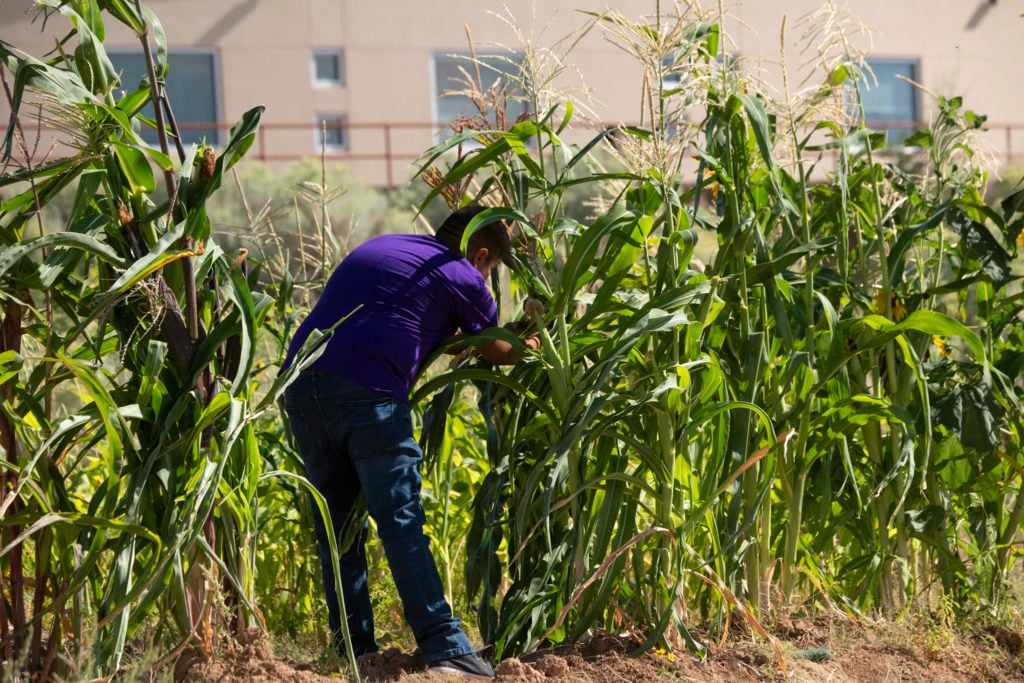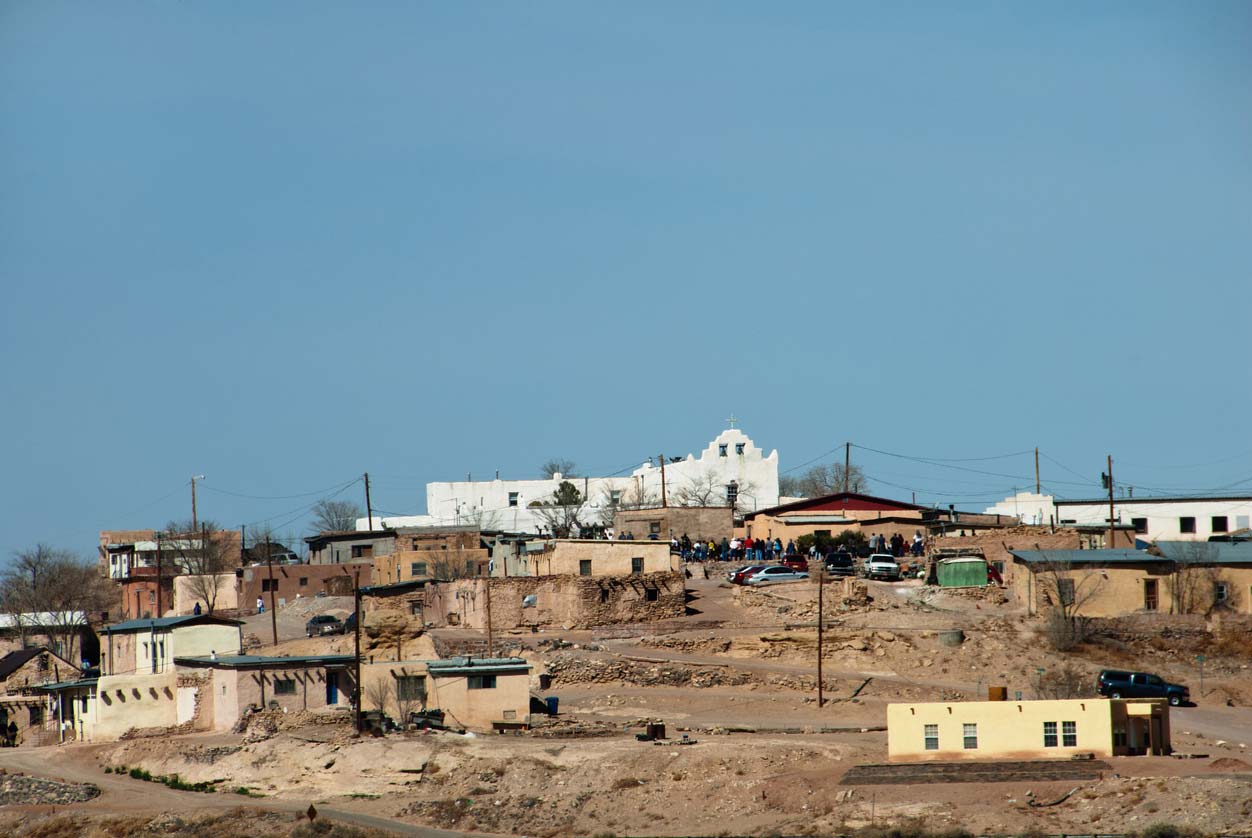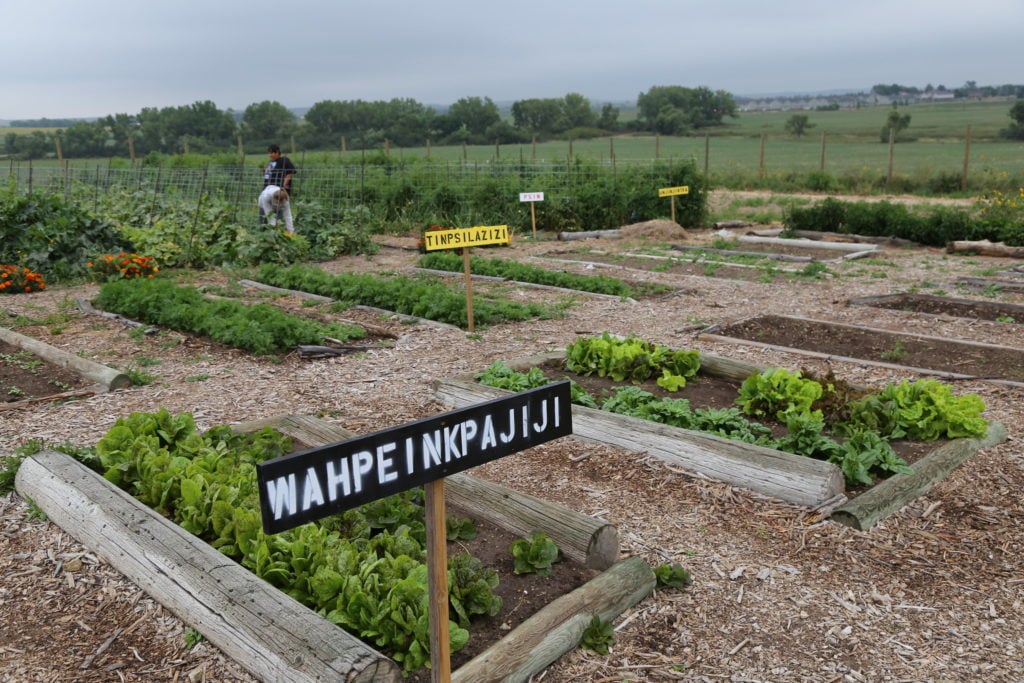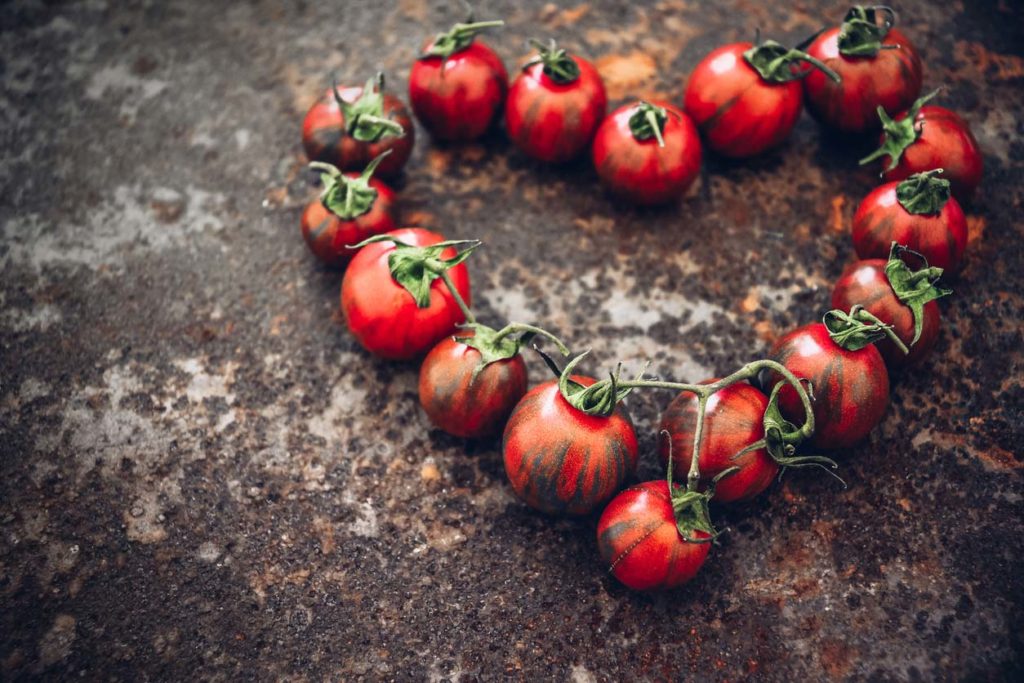by Liana Minassian: Everybody eats. We all need food to live, and we all need healthy food to be healthy…
But not everyone has equal access to healthy food. In fact, of all the ethnic groups represented in the Americas, there’s one that consistently has the least access to healthy food and has suffered some of the worst health outcomes and rates of chronic disease.
Indigenous peoples disproportionately experience a lower life expectancy, more chronic conditions, and overall lower quality of life. They also face significant amounts of poverty, chronic disease, and violence — as well as food insecurity.
In the Americas, Native peoples have been forcibly evicted from their ancestral lands and relocated to remote locations where they no longer have access to their traditional plants, medicines, and ecosystems. As a result of these evictions, and in some cases, because of forced integration into the colonizing culture, many Indigenous groups have struggled to keep their cultural traditions alive, including their native diets. Instead, many Indigenous peoples have had to rely on government assistance programs, subsisting on refined and processed foods for survival — while also experiencing less access to and discrimination in healthcare services.
But over the last few decades, despite the grim realities many Indigenous Nations still face, a movement towards food sovereignty has expanded. And many Native peoples have sought to reclaim and reconnect with their traditional or Indigenous food systems — and by extension, their health, both individual and communal.
Defining Indigenous Foods and Food Systems

Dana Thompson (lineal descendant of the Wahpeton-Sisseton and Mdewakanton Dakota tribes and a lifetime Minnesota native) is executive director of North American Traditional Indigenous Food Systems (NATIFS), a nonprofit working to improve Indigenous food access and education. As she explained to us in an interview, Indigenous food systems encompass more than the specifics of what’s on the store shelves and on people’s plates. They include “…how the foods are produced and that the foods are grown in an environmentally sustainable way.”
According to Thompson, Indigenous food access and education “…can help us to reclaim the health of Indigenous foods, which is really important. And it’s not just physical health; it’s spiritual health; it’s cultural health.”
As for the Indigenous foods themselves, they are those that Nations have historically had access to within their region of origin from farming, hunting, or wild-harvesting. Because climates and ecosystems vary widely, so, too, did traditional Indigenous diets in the Americas.
As Thompson explains, “If you’re down in the Southwest, you’re going to have access to cholla buds and all sorts of different stuff, all the great foods out of the desert. If you’re up in the Pacific Northwest, you’re going to have access to the ocean and all of those ecoregions inland with all the forests and different types of foods.”
Although traditional diets of Indigenous people in the Americas varied widely by region, what united them was unprocessed, whole, plant-based foods, coupled with wild fish and/or game. Their diets generally consisted of a healthy balance of macronutrients and were naturally low-fat and rich in vitamins, minerals, fiber, and complex carbohydrates that provided lasting energy.
But we’re not here to paint a romanticized picture of life in the Americas before colonization. Indeed, researchers believe that life expectancy in many parts of the Americas before colonization may have been low by today’s standards. But there’s also little doubt that when the Europeans arrived, they reached a continent that was lush with natural resources — abundant in topsoil — and in plant and animal life. The Native Americans that lived on the continent had done so sustainably and clearly hadn’t made a mess of things.
Learning from Indigenous Land Management

Although there’s some controversy over exactly how many thousands of years Indigenous people have lived in the Americas, there’s little doubt that traditional Indigenous food systems accomplished something that the modern industrial diet has not: they were sustainable and regenerative. In fact, they were sustainable because they were regenerative — a term that refers to agricultural practices that improve the fertility of the land rather than degrading it over time.
While many traditional foods were wild-harvested or hunted, Indigenous peoples also remained interconnected to their ecosystems through regenerative farming practices and land management.
In the Americas, Indigenous Nations managed complex ecosystems with agroforestry, which is defined by the USDA as “the intentional integration of trees and shrubs into crop and animal farming systems to create environmental, economic, and social benefits.” This type of farming system helps protect crops from extremes in weather while also allowing for a variety of resources to be harvested from one location. Plus, it can also increase soil fertility and add more carbon to the soil, which is particularly significant now since it can help to offset greenhouse gases contributing to climate change.
Intercropping and polyculture have also been used in a similar way by Indigenous cultures, increasing production by planting multiple crops together. The “three sisters” crops — corn, beans, and squash — are an early example of intercropping among Native Americans. Research has shown that these crops have a complementary relationship and that planting them together increases both their nutrient levels and their yield.
These practices also produce crops that are more resilient in the face of pests and extreme weather.
Now, farmers, permaculturists, and ecologists are increasingly looking to Indigenous wisdom for insights on how we can live in a more balanced way. Industrialized agriculture has become one of the most environmentally destructive forces on the planet — depleting groundwater, topsoil, and forest cover; polluting our air and water; and destabilizing our climate. But Indigenous farming wisdom holds keys that could be of real value to the future of humanity.
But Indigenous farming wisdom holds keys that could be of real value to the future of humanity.
The Introduction of the Reservation System

Although there’s a lot we can learn from traditional Indigenous farming and land management, the sad truth is that much of this knowledge has been lost over time. Many Nations have had to relearn the ways of their ancestors due to the loss of Elders, forced assimilation in Native American boarding schools, the dominance of modern food technologies, and many other restrictions placed on them by colonizing forces.
But although colonization’s impact on traditional food systems started much earlier, it was the imposition of reservations in the United States that systematically separated Indigenous people from their traditional land and food ecosystems.
When the reservation system was created, many Nations were forcibly removed from their native lands and driven to remote locations. It was thought that by doing so, they could avoid conflict with white settlers. In fact, many reservation lands were selected just because white settlers didn’t desire them. Lands selected for reservations were often barren and ill-suited for hunting, wild harvesting, or traditional forms of agriculture.
Reservations have had a lasting impact on both Indigenous food knowledge and access. They made finding and harvesting Indigenous foods for many Nations nearly impossible, especially in amounts that could sustain a population.
Food Insecurity and Colonizer Foods
Because Indigenous peoples were displaced from their native lands and forced onto reservations, they started to rely on colonizer foods provided by the US government. White flour, lard, sugar, dairy products, and canned meats were provided for Indigenous Peoples to subsist on — a stark contrast from the unprocessed, whole foods they were used to. Although processed food products were foreign to Native Nations, these foods quickly became a survival necessity as access to traditional foods decreased.
Because of the relative isolation of reservation land, many reservations also became “food deserts,” with limited access to fresh fruits, vegetables, and other healthy whole foods. Even though the reservation system was created back in 1851, it continues to have a devastating impact on Native Nations. Today, one in four Indigenous people living on reservations experience periods of food insecurity.
In the Klamath River Basin (home to the Karuk, Yurok, Hoopa, and Klamath tribes), a 2019 survey found that 92% of tribal households were food insecure. And only 7% of those surveyed reported access to traditional foods. Even if Indigenous peoples can access nearby grocery stores or healthy food, brutal poverty on reservations means that they may not be able to afford that food. One in three Native Americans lives in poverty, forcing many tribal members to continue to rely on US government food aid for their survival. Unfortunately, the program offers an extremely limited variety (only 100 items) of food choices — the majority of which continue to be processed foods with little nutritional value.
Chronic Lifestyle Disease
Indigenous people also face significant health disparities. In fact, Native Americans are more likely than any other ethnic group in the US to report poor health status.
As Dana Thompson of NATIFS explained in her interview with us, from the beginning of the food aid program, the foods provided by the US government have played a major role in the poor health of tribal communities. “They started seeing these foodborne illnesses pop up in the form of inflammatory diseases, starting with tooth decay and going so far as to… cause diabetes, heart disease, hypertension, cancer, mental health problems, and addictions.”
In the United States, Indigenous people have much higher rates of chronic disease, along with lower life-expectancies, compared to non-Indigenous people. And one of the biggest risk factors for developing these lifestyle diseases is the high rates of obesity seen among Native Americans. A 2018 National Health Institute Survey found that 48% of Indigenous people in the US were obese. This has also led to particularly alarming rates of type 2 diabetes. According to the International Diabetes Federation, over half of Indigenous adults have type 2 diabetes. That’s more than any other US racial group; twice the incidence among white Americans; and with a staggering, five times higher rate of diabetes-caused kidney failure.
Heart disease also often accompanies obesity and is the leading cause of death amongst Native Americans. And even though heart disease rates have gone down over the past 25 years due to increased preventive care measures, cancer incidence continues to climb among Native Peoples due to higher rates of obesity, poor diet, smoking, lack of physical activity, and infrequent health screenings.
Sadly, that also means Native Americans have been disproportionately affected by the coronavirus as well. Indigenous people in North America have already died at twice the rate of white people from COVID-19.
Food Sovereignty and the Re-Indigenization of Diet

Although the social disparities facing Native Nations are grim, there are many community leaders and organizations that recognize the connection between the diets and health of Indigenous populations — and are actively working to improve them.
Food sovereignty is a term often used in association with the Indigenous foods movement. It comes from La Via Campesina, an international umbrella organization working for peasant and Indigenous rights. They define food sovereignty as “… human beings having direct, democratic control over the most important elements of their society – how we feed and nourish ourselves, how we use and maintain the land, water, and other resources around us for the benefit of current and future generations, and how we interact with other groups, peoples and cultures.”
Indigenous food sovereignty takes that model and applies it to tribal systems, putting the power of food back into the hands of Indigenous communities.
As outlined during the International Forum for Food Sovereignty, the seven pillars of food sovereignty are:
- Focuses on food for people
- Builds knowledge and skills
- Works with nature
- Values food providers
- Localizes food systems
- Puts control locally
- Food is sacred
Food sovereignty advocates seek to help Indigenous peoples to decolonize and re-indigenize their diets. In doing so, they can reconnect with their ancestral foodways and reclaim power over their own bodies and health.
And I feel compelled to add here that we could all do well to remind ourselves of this body of knowledge and way of living in the world. Unless non-Indigenous peoples begin to adopt these same pillars, it’s hard to see how we can keep our civilization going for much longer. It’s fine to point to the three sisters as examples of Indigenous farming knowledge, but the true wisdom we need to save ourselves comes from these deeper principles: humans weaving community in direct connection with a land base — and in ways that sustain both the community and the land.
Indigenous Food Organizations to Support
Many organizations and businesses among Indigenous populations are working toward furthering the Indigenous foods and food sovereignty movements. Here are a few. Check out each of their websites to learn more about what they’re doing and ways you can help support their work.
1. North American Traditional Indigenous Food Systems (NATIFS)
Sean Sherman, also known as The Sioux Chef, and Dana Thompson started NATIFS to provide education and access to Indigenous foods and foodways. Their work addresses and seeks to heal ancestral trauma using food, by promoting greater health and connection to Indigenous wisdom. They recently opened the first Indigenous Food Lab in Minneapolis, MN, which will be a culinary training center for working with Indigenous foods. “Our team is working really hard to build this educational model so that there are opportunities — there’s the curriculum for people to just get the fundamentals — so they can bring that knowledge back to their own communities and set up their own businesses,” Thompson informed us. You can donate, join their mailing list, or follow them on social media to keep up with their work.
2. Native Seeds/SEARCH (NS/S)
Native Seeds/SEARCH is a seed-saving nonprofit based in the southwestern United States. They work to protect traditional foods, biodiversity, farming techniques, and the cultural heritage of Indigenous communities by providing seed saving and farming training. Self-identifying Native Americans can order heritage seeds directly from their website. They also have an Adopt-a-Crop program and an online store with locally made food products for the general population to purchase.
3. Ojibiiikaan Indigenous Cultural Network
Ojibiiikaan Indigenous Cultural Network works primarily with Indigenous youth and their communities in the Toronto area. Their programs help to revitalize knowledge of Indigenous food and food systems through growing practices and gardening, traditional Indigenous cooking, and education of medicinal plants. They accept monetary donations as well as Indigenous seeds and rootstock.
4. White Earth Land Recovery Project
Founded by internationally renowned environmental and Native American activist, Winona LaDuke, White Earth Land Recovery Project is a nonprofit working to preserve and restore the land of the White Earth Indian Reservation while committing to re-indigenizing and revitalizing their cultural identity. Some of the projects they’re currently working on include promoting food sovereignty through a tribal food policy as well as farm to school initiatives. They also have an Indigenous seed library and sell traditional foods and crafts through their Native Harvest brand.
5. mak-‘amham (& Cafe Ohlone)
Vince Medina of the Muwekma Ohlone Tribe and Louis Trevino of Rumsen Ohlone tribe created an organization called mak-’amham (meaning “our food” in the Chochenyo Ohlone language) to preserve their nation’s traditional foods. Based in what is now the Bay Area of California, they gather pre-colonial Indigenous foods themselves in areas of their ancestral homelands. Before COVID-19 hit, they had both a catering business and a pop-up restaurant called Cafe Ohlone.
Although at the time of this writing, the restaurant is closed due to COVID-19, they are still bringing the flavors and culture of the Ohlone to people in the Bay Area. In addition to providing complimentary fresh meals as a service to Elders in their community, they’ve also launched curated dinner boxes that include two meals, a candle, and a curated playlist to immerse you in the Cafe Ohlone dining experience. A portion of the proceeds of these boxes goes back to the Ohlone community and also helps support the cafe as they work towards securing a new brick-and-mortar restaurant and cultural space.
Food is Life

Native peoples have suffered immense trauma through centuries of genocide, disruption of their culture, language, ecosystems and food systems, and in some cases, forced relocation. But everywhere there is a problem, there are people finding solutions. And in Native communities, leaders are emerging with beacons of hope for their people and for all of us.
The truth is that if you go back far enough, all of us have Indigenous ancestors. All of us have roots in a food system based around real, whole, and natural foods that came from the Earth. And perhaps we would be well advised to bring some of the wisdom of our ancestors into our future. Humans can eat real food. We can live sustainably on this planet. And we can treat one another, as well as animals and our environment, with respect.
FROM THE EDITOR OF AWAKEN.COM –
We are proud to announce a new partnership with Food Revolution to bring our readers Seminars and Masterclasses on health, nutrition and Earth-Conscious living.
Sign up now for a free spot in a Master Class On Rewiring Your Brain For A Healthier Life


















































